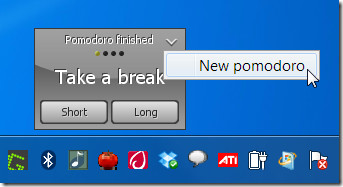
For Ubuntu Mate then right click on the desktop and select “Create Launcher …” then add the various details and a launcher complete with icon will appear on the desktop. The GitHub repository contains a “.desktop” file which can be dragged onto the Ubuntu Launcher to create a shortcut complete with a suitable icon. The countdown is done in the countdown() function and the dialog is updated using the following lines: printf "# Time remaining: %d:%02d\n" $(( t/60 )) $(( t % 60 )) Įcho "$(( ( ( TIME - t ) * 100 ) / TIME ))"

If a line contains only a number, the percentage is updated with that number.”

If a line is prefixed with #, the text is updated with the text on that line. “Zenity reads data from standard input line by line.
#POMODORO TIMER TOMIGHTY MANUAL#
The key here are the following lines from the “ Process Dialog” manual page: The only one that’s slightly convoluted is the display of the progress bar: The Zenity commands are all explained in the manual. The user can abort the whole process at any time but there’s currently no way of handling any interruptions to a particular Pomodoro.ģ. The script simply asks the user for the number of Pomodoros then steps through each one displaying the various countdowns as necessary. The whole script is a bit Ubuntu-centric where the notification sound is concerned but it’s a simple matter to change the appropriate line if necessary.Ģ. The time intervals for the Pomodoros are those defined by the Pomodoro Technique website but feel free to modify as necessary. There are a number of default values at the start of the script. The code is available on GitHub ( ) and is largely self explanatory but the following may be useful to note:ġ.
#POMODORO TIMER TOMIGHTY INSTALL#
To use the script you may need to install Zentity, depending on your distro. After some deliberation I implemented the basic control in a shell script and used Zenity to provide the user interaction.

rather than having to use a terminal window. I did think of making it purely command line shell based but I find it more useful to have a small window on screen showing the time remaining etc. So I did what any self respecting engineer would do and I wrote my own 🙂 There are plenty of web based ones available but all the native Linux versions I found seemed to need either Java or libraries that I didn’t have installed. On a Windows PC I found Tomighty to be quite effective but unfortunately there isn’t a Linux version. With the Pomodoro Technique I could cleanly partition my work, for example, do three Pomodoros working on a project followed by one for email, one for phone calls etc. When I was a manager or developer on software projects then it was too easy to get distracted by things like email or other discussions. If I have difficulty concentrating on a task I find the Pomodoro Technique very useful.


 0 kommentar(er)
0 kommentar(er)
